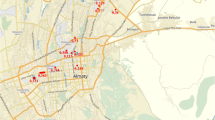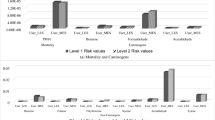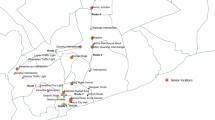Abstract
The shipbuilding industry of Korea, ranked number one in the world in annual amount of ship orders, has contributed to national economic growth; however, this has resulted in various environmental problems. Characteristics of environmental pollution, such as particulate matters, odor, and noise, which are closely related with public complaints, were evaluated in an industrial shipbuilding complex. The concentrations of PM-10 and TSP were significantly affected by the distance between the measurement site and shipbuilding workplace, as well as the height of the measurement site. Average PM-10 concentrations in the residential area ranged from 40.10 to 44.10 μg/m3, which were not high in comparison with the ambient air quality standard and those of major cities in Korea. Paint particles could affect a wider area than typical particulate matters due to their generation and transport properties. The properties of odor in the study area were widely affected by the work intensity in shipyards and the temperature. Twenty-five out of total 54 samples collected in the residential area exceeded the dilution factor of 10, which is the tolerable limit adopted in Korea. Noise had an influence on a limited area due to the extinction effect with distance from the shipyards, while severe noise levels higher than 90 dB(A) were frequently found inside the shipyards.
Similar content being viewed by others

References
Celebi, U. B., & Vardar, N. (2008). Investigation of VOC emissions from indoor and outdoor painting processes in shipyards. Atmospheric Environment, 42, 5685–5695.
Chen, C. F., Kao, C. M., Dong, C. D., Chen, C. W., et al. (2009). Butyl tin contamination in sediments and seawater from Kaohsiung Harbor, Taiwan. Environmental Monitoring and Assessment. doi:10.1007/s10661-009-1152-x.
Chiu, S. W., Ho, K. M., Chan, S. S., So, O. M., Lai, K. H., et al. (2006). Characterization of contamination in and toxicities of a shipyard area in Hong Kong. Environmental Pollution, 142, 512–520.
Choi, M., Choi, H. G., Moon, H. B., Kim, G. Y., et al. (2009). Spatial and temporal distribution of tributyl tin (TBT) in seawater, sediments and bivalves from coastal areas of Korea during 2001–2005. Environmental Monitoring and Assessment, 151, 301–310. doi:10.1007/s10661-008-0271-0.
Chung, J. W., & Lee, M. E. (2009). Case study of hazardous air pollutant concentrations in residential areas nearby small and medium scale shipbuilding companies. Journal of the Environmental Sciences, 18, 517–525.
Clarkson Research Services Limited (2009). World Shipyard Monitor, 16(12), 22.
Dincer, F., & Muezzinoglu, A. (2006). Chemical characterization of odors due to some industrial and urban facilities in Izmir, Turkey. Atmospheric Environment, 40, 4210–4219.
Donham, K. J., Wing, S., Osterberg, D., Flora, J. L., Hodne, C., Thu, K. M., et al. (2007). Community health and socioeconomic issues surrounding concentrated animal feeding operations. Environmental Health Perspective, 115(2), 317–320.
GRETeC (2006). Survey on air pollution generated from large scale shipbuilding process in Geoje. GRETeC 06-2-40-41.
GRETeC (2007). Study on environmental problems and management programs for shipbuilding and subcontract companies in Gyeongnam. GRETeC 07-2-40-41.
Kim, K. H., & Park, S. Y. (2008). A comparative analysis of malodor samples between direct (olfactometry) and indirect (instrumental) methods. Atmospheric Environment, 42, 5061–5070.
Korfali, S. I., & Massoud, M. (2003). Assessment of community noise problem in greater Beirut area, Lebanon. Environmental Monitoring and Assessment, 84, 203–218.
KMOE (2009a). Annual report of ambient air quality in Korea, 2008. Seoul: Korean Ministry of Environment (KMOE).
KMOE (2009b). Estimation of odor damage reparation in the region of concentrated emission source area. Seoul: Korean Ministry of Environment (KMOE).
Malherbe, L., & Mandin, C. (2007). VOC emissions during ship painting and health-risk assessment. Atmospheric Environment, 41, 6322–6330.
Miedema, H. M. E., Walpot, J. I., Vos, H., Steunenberg, C. F., et al. (2000). Exposure-annoyance relationship for odour from industrial sources. Atmospheric Environment, 34, 2927–2936.
Nicell, J. A. (2003). Expressions to relate population responses to odor concentration. Atmospheric Environment, 37, 4955–4964.
Nicell, J. A. (2009). Assessment and regulation of odour impacts. Atmospheric Environment, 43, 196–206.
Shim, W. J., Oh, J. R., Kahng, S. H., Shim, J. H., & Lee, S. H. (1999). Horizontal distribution of butyl tins in surface sediments from an enclosed bay system, Korea. Environmental Pollution, 106, 351–357.
Wade, T. L., Sweet, S. T., Quinn, J. G., Cairns, R. W., King, J. W., et al. (2004). Tributyl tin in environmental samples from the former Derecktor shipyard, Coddington cove, Newport RI. Environmental Pollution, 129, 315–320.
Weerd, J., Veen, M. K., Heeren, M. A., Boon, J. J., et al. (2003). Identification of pigments in paint cross sections by reflection visible light imaging microspectroscopy. Analytical Chemistry, 75, 716–722.
Wilson, W. E., & Suh, H. H. (1997). Fine particles and coarse particles: Concentration relationships relevant to epidemiologic studies. Journal of the Air and Waste Management Association, 47, 1238–1249.
Wilson, W. E., Chow, J. C., Claiborn, C., Fusheng, W., Engelbrecht, J., Watson, J. G., et al. (2002). Monitoring of particulate matter outdoors. Chemosphere, 49, 1009–1043.
Woo, Y. S. (2003). Spatial features of production networks on Korean shipbuilding: The case of Samsung heavy industry in Koje, Korea. Journal of the Economic Geographical Society of Korea, 6, 99–117.
Author information
Authors and Affiliations
Corresponding author
Rights and permissions
About this article
Cite this article
Chung, JW., Lee, ME. & Lee, HD. Characteristics of environmental pollution related with public complaints in an industrial shipbuilding complex, Korea. Environ Monit Assess 177, 73–84 (2011). https://doi.org/10.1007/s10661-010-1619-9
Received:
Accepted:
Published:
Issue Date:
DOI: https://doi.org/10.1007/s10661-010-1619-9



